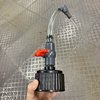chemgeek
En-Route
- Joined
- Dec 5, 2009
- Messages
- 3,111
- Display Name
Display name:
chemgeek
How to you ground something that is non-conductive?????
Not easily, because most plastics are great insulators, which is why they can build up a such a good static charge. This is one reason why every solvent safety can in the chem lab is made of metal. Solvent fires are not fun.











